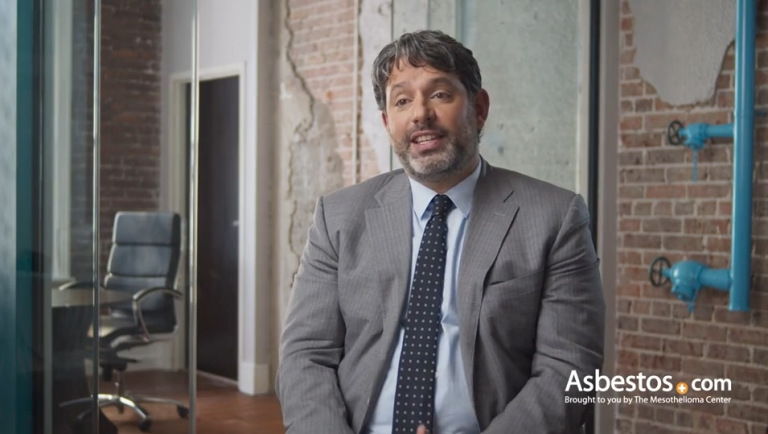Kim Madril’s insurance wouldn’t cover her mesothelioma treatment expenses. Unable to continue working as a nurse, the cost of treatment was an obstacle. Madril decided to consider getting financial help through compensation. She said it helped put her in a position financially, emotionally and mentally, eliminating some of the stress and allowing her to focus on recovery.
Asbestos Liability
Asbestos liability means companies may be legally responsible for exposing people to asbestos. Those who developed mesothelioma or asbestos-related diseases may qualify for compensation from those who failed to warn or protect them.
Understanding Asbestos Liability
Asbestos liability is the legal responsibility companies face when exposure to asbestos leads to serious health conditions like mesothelioma. These cases often involve manufacturers, property owners or employers who failed to protect people from known risks.
Key Facts About Asbestos Liability
- More than $30 billion available in asbestos trust funds.
- About 1 in 3 mesothelioma legal cases involves a U.S. veteran.
- Many asbestos lawsuits involve multiple liable employers.
- Navy veterans file more than half of all military asbestos claims.
When companies are found liable, survivors or their families may file mesothelioma lawsuits, claim compensation through asbestos trust funds or apply for VA benefits. These claims help hold negligent parties accountable and provide financial support during a difficult time. Asbestos liability cases vary, but they share a common goal: helping people get justice and financial help after a life-changing diagnosis.
How Is Asbestos Liability Determined?
Proving asbestos liability means showing that someone was exposed to asbestos and that the exposure caused an illness like mesothelioma. Most claims rely on medical records, employment or military service documents, and proof that a company acted negligently or failed to warn of known dangers.
It’s not uncommon for claims to involve multiple responsible parties. A single exposure might involve an asbestos manufacturer, an employer and a property owner. Legal experts work to connect the exposure to specific companies or locations.
In these types of lawsuits, specifically mesothelioma lawsuits, you don’t typically file against your employer. You file against the companies that manufactured the asbestos-containing products.
Negligence
Negligence is one of the most common ways asbestos liability is proven. A company may be negligent if it ignored safety rules, failed to provide protective gear, or didn’t inform workers about the risks of asbestos.
When workers are harmed because of this lack of care, the company can be held legally responsible. Employers and manufacturers are often found negligent for not following Occupational Safety and Health Administration guidelines.
Strict Liability
Strict liability applies when a company is responsible for the harm its products caused, even if the company didn’t act intentionally. With asbestos liability, this might apply to companies that sold or used asbestos-containing products without warning users.
Many construction materials like insulation, roofing materials and floor tiles contained asbestos. Companies that made these products may face strict liability claims from people who became ill after using them, even if the products were made decades ago.
Breach of Warranty
Breach of warranty claims in asbestos liability cases happen when a company falsely claimed that a product was safe to use. These cases are based on broken promises or guarantees made about the product.
If a company sold products containing asbestos and asbestos exposure from those products led to illness, that’s a breach of warranty. For example, if a company sold asbestos floor tiles labeled as “safe” or “non-toxic,” and they caused mesothelioma, the company may be found liable for breach of warranty.

Get help finding a top attorney who can get you the compensation you deserve.
Get Help NowWho Is Liable for Asbestos Exposure?
Employers, product manufacturers, property owners, and government contractors may be held liable for exposing people to asbestos. Veterans can’t sue the military, but they can sue asbestos manufacturers or contractors.
Possible Liable Parties in Asbestos Claims
- Asbestos product manufacturers: Sold dangerous asbestos products without warnings, despite knowing the risks.
- Construction and shipbuilding companies: Commonly used asbestos and failed to protect workers.
- Employers: Ignored OSHA standards or failed to provide safety gear.
- Military contractors: Supplied asbestos products without warnings; some may have legal protections.
- Mines, distributors and suppliers: Provided dangerous raw mined asbestos and asbestos-containing products without proper warnings or protections, despite knowing the health risks.
- Property owners: May have exposed tenants or workers to asbestos without proper disclosure.
Some claims involve more than one type of defendant, depending on where and how the exposure happened. A knowledgeable mesothelioma lawyer can help identify all responsible parties and explain your legal options. Holding those accountable may result in compensation to help cover your medical bills and other expenses.
You wouldn’t sue the government or the armed forces. Rather, the lawsuits filed would be against the manufacturers, distributors and installers of the asbestos-containing materials.
What Compensation Is Available Through Asbestos Liability Claims?
People diagnosed with mesothelioma may be eligible for asbestos liability claim options such as lawsuits, asbestos trust funds or VA benefits. This mesothelioma compensation can help pay for medical care, lost wages and other expenses related to asbestos exposure.
You can sue for asbestos exposure if you can prove the exposure caused your illness and the company responsible failed to protect or warn you. Since these cases involve complex legal and medical issues, an experienced mesothelioma lawyer can help determine which claims you qualify for and guide you through the process.
As pleural mesothelioma survivor Kim Madril tells us, “I’m happy I pursued legal representation. I stood for something I thought was right. And I ended up with a bit of security and college money for my children. I thought to myself, ‘The compensation part is a bonus, but the other thing is let’s make these entities accountable.’”
Veterans may qualify for additional VA benefits claims, including disability compensation, specialized health care and pension benefits. VA-accredited claims agents can help veterans and their families understand and access these benefits.
Asbestos Bankruptcy Trusts
Many companies that made asbestos products went bankrupt to protect themselves from mounting asbestos lawsuits. Courts required them to create asbestos trust funds to pay current and future survivors of asbestos-related diseases. Trust fund claims often provide faster compensation than lawsuits and don’t require going to court.
Class-Action Lawsuits and Multidistrict Litigation
Some asbestos lawsuits are grouped into class actions or multidistrict litigation, commonly known as MDLs. These allow many people with similar claims to seek justice together, but most mesothelioma cases are handled individually to maximize compensation.
Commonly Asked Questions About Asbestos Liability
- How does asbestos exposure lead to legal liability?
-
Mesothelioma is primarily caused by exposure to asbestos. The asbestos companies are liable to mesothelioma victims for exposure to their asbestos products.
Answered By: Carl Money, Mesothelioma Attorney, Nemeroff Law Firm
- What factors determine responsibility in asbestos-related cases?
-
There are several factors that help determine responsibility that your mesothelioma attorney can explain to you, including identification and exposure to asbestos products.
Answered By: Carl Money, Mesothelioma Attorney, Nemeroff Law Firm
- Are there time limitations for filing asbestos liability claims?
-
Depending on the state, you generally have anywhere from 1 to 3 years from the date of diagnosis or date of death to file a lawsuit. As for filing claims with the various asbestos trusts, you generally have 3 years from the date of diagnosis or date of death to file a claim against the asbestos trusts.
Answered By: Carl Money, Mesothelioma Attorney, Nemeroff Law Firm
- Can family members sue for asbestos-related illnesses if the affected individual has passed away?
-
Yes, family members can file a wrongful death mesothelioma lawsuit after the victim has passed away.
Answered By: Carl Money, Mesothelioma Attorney, Nemeroff Law Firm






